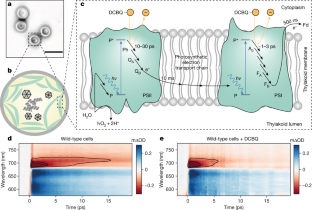2023-03-22 ケンブリッジ大学
超高速分光法を使用して、国際的な物理学者、化学者、および生物学者からなるチームは、植物、藻類、および一部の細菌が太陽光をエネルギーに変換する過程である光合成を、超高速なタイムスケールで、生きた細胞で研究することができました。新しい発見は、Nature誌に掲載されています。
<関連情報>
- https://www.cam.ac.uk/stories/hacking-photosynthesis
- https://www.nature.com/articles/s41586-023-05763-9
ピコ秒のタイムスケールで光合成の配線が変更される Photosynthesis re-wired on the pico-second timescale
Tomi K. Baikie,Laura T. Wey,Joshua M. Lawrence,Hitesh Medipally,Erwin Reisner,Marc M. Nowaczyk,Richard H. Friend,Christopher J. Howe,Christoph Schnedermann,Akshay Rao & Jenny Z. Zhang
Nature Published:22 March 2023
DOI:https://doi.org/10.1038/s41586-023-05763-9

Abstract
Photosystems II and I (PSII, PSI) are the reaction centre-containing complexes driving the light reactions of photosynthesis; PSII performs light-driven water oxidation and PSI further photo-energizes harvested electrons. The impressive efficiencies of the photosystems have motivated extensive biological, artificial and biohybrid approaches to ‘re-wire’ photosynthesis for higher biomass-conversion efficiencies and new reaction pathways, such as H2 evolution or CO2 fixation1,2. Previous approaches focused on charge extraction at terminal electron acceptors of the photosystems. Electron extraction at earlier steps, perhaps immediately from photoexcited reaction centres, would enable greater thermodynamic gains; however, this was believed impossible with reaction centres buried at least 4 nm within the photosystems4,5. Here, we demonstrate, using in vivo ultrafast transient absorption (TA) spectroscopy, extraction of electrons directly from photoexcited PSI and PSII at early points (several picoseconds post-photo-excitation) with live cyanobacterial cells or isolated photosystems, and exogenous electron mediators such as 2,6-dichloro-1,4-benzoquinone (DCBQ) and methyl viologen. We postulate that these mediators oxidize peripheral chlorophyll pigments participating in highly delocalized charge-transfer states after initial photo-excitation. Our results challenge previous models that the photoexcited reaction centres are insulated within the photosystem protein scaffold, opening new avenues to study and re-wire photosynthesis for biotechnologies and semi-artificial photosynthesis.


